By Derrill De Heer[1]
One hundred victories in one hundred battles is not the most skilful
Subduing the other’s military without battle is the most skilful.
Sun Tzu. 500 B.C.
From Chapter 3 strategy of Attack[2]
When the 1st Australian Task Force deployed to Vietnam in May-June 1966 the Australian Army had already developed doctrine for the conduct of what it called counter revolutionary warfare. That doctrine stated that ‘psychological warfare’ (psywar) plays a vital role in counter insurgency’.[3] But despite acknowledging this ‘vital role’, the Task Force initially included no psychological warfare capability. It was not until April 1970, when the war was winding down, that the 1st Australian Psychological Operations Unit (1 Psyops Unit) was raised. By this time the enemy in Phuoc Tuy Province had already won some significant psyops victories in the absence of any 1ATF or Free World military effort. For example, following the battle of Long Tan on 18 August 1966, Viet Cong psychological operations were already convincing the local population that the Australians had suffered a major defeat. This story was also broadcast on radio Hanoi and radio Peking. 1ATF had no capacity to pitch a counter story.
To fill this gap, officers and soldiers from units already deployed to Vietnam as part of the 1st Australian Task Force (1ATF) were brought together to form the unit. It consisted of three officers and 23 soldiers who each possessed skills that contributed to the unit. The unit had been able to source a printer, photographer, translators/interpreters, clerks and field soldiers within 1 ATF. Some of these people, whether National Servicemen or regulars, had these trades before joining the army. In my case, I was chosen because I had previous service in South East Asia, notably in Malaya, Singapore and Thailand, and had experience working with other cultures.
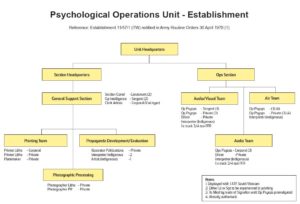
I was appointed to command the two Psyops ground teams and one air team. Australia had not had its own psychological operations unit since the Far East Liaison Office (FELO) in the South West Pacific theatre in the Second World War. The skills of psychological operations and familiarity with its employment and capabilities had been lost. The need to recover these skills created a huge learning effort by the newly formed operational teams as they had no formal training courses in psychological operations. About eight soldiers of the different teams were sent to the US Army base at Bien Hoa with members of the ground and air operations team, for a one-week, hastily put together training course, run by the United States Army psychological operations battalion. Among them were National Serviceman Private (later Corporal) Ian Botham, the printer, and regular army soldier Private Daniel ‘Speedy’ Wright, the photographer and plate maker. It was hardly enough training, but was all we could scrounge and we were grateful to receive it.
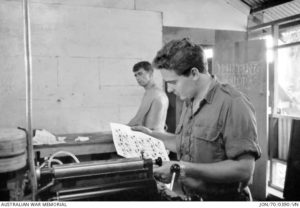
Corporal Ian Botham, serving with the 1st Psyops Unit of 1ATF, examines the first run of a leaflet containing a message from a Hoi Chanh, a former Viet Cong (VC), who has rallied to the Government’s side, to his friends who are still VC.
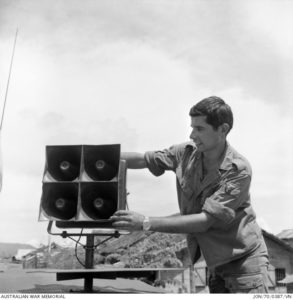
Private Wally Koscielecki adjusts a loudspeaker mounted on a Land Rover during a visit by the 1st Psychological Operations Unit to Hoi My village. The operation made contact with the people of the village, south east of the 1ATF base at Nui Dat.
The unit had an air team of one corporal and two private soldiers. The ground teams consisted of a team leader, a driver (for the team vehicle), one psyops operator, one South Vietnamese sergeant interpreter/translator and one South Vietnamese Bushman Scout. Bushman Scouts were former Viet Cong soldiers who had rallied to the South Vietnamese Government side under the Chieu Hoi program (or ‘Open Arms’, Returnee scheme) and had completed a six-week indoctrination course at the Province Chieu Hoi centre after which they were deemed suitable to serve with Australian or American units for their expert knowledge of Viet Cong tactics and techniques. They were known as Hoi Chans (meaning returnees). Once working with allied units the Americans called them Kit Carson Scouts and the Australians called them Bushman Scouts.
One ground team was commanded by me and the other was commanded by a Corporal. I programmed all ground and air missions.
The Air Team
When an enemy unit had been in contact with a 1ATF unit, and a firefight had occurred, the air team was often deployed to the vicinity with the aim of encouraging some of the enemy to rally to the government side. If the enemy unit had been identified as being a main force or district unit, or was suspected of being so, the air team would select a range of leaflets (see below) for the mission. These would include a ‘Safe Conduct’ leaflet and leaflets that were more general in nature but related to the ‘Chieu Hoi’ scheme. Usually, the minimum drop was about 120,000 to 240,000 leaflets in a mixed drop. In consultation with the Intelligence Sergeant (the Intelligence Officer was usually deployed under Detachment 1 Division Intelligence Unit as an Intelligence Liaison Officer to a District called MILO’s) an area would be selected where the drop would take place. The leaflets were about 15 cm x 7.6 cm (6 inch x 3 inch) or 12.7 cm x 10.2 cm (5 inch x 4 inch) in size. Size and weight of the leaflets was significant because it affected the scatter of the dropped leaflets.
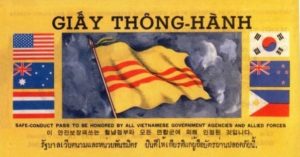
Safe Conduct Leaflet printed by US Psyops unit based in Okinawa.
An aircraft, usually a helicopter, would be requested and if approved the plan would kick into place. An aircraft ‘approval form’ was completed and walked through the air cell at Headquarters 1ATF. If approved by the air cell, they notified the artillery net about the time and target area for the leaflet drop so that possible friendly fire incidents could be avoided. The air team had to give a copy of this form to the pilot prior to take-off.
I had acquired (relocated) a lightweight metal chute on a previous trip to Bien Hoa that clipped onto the floor of a Huey helicopter. The chute protruded out of the aircraft and down near the skid. The following picture shows the leaflets coming out of the chute and the disbursement in the air over the area to be covered.
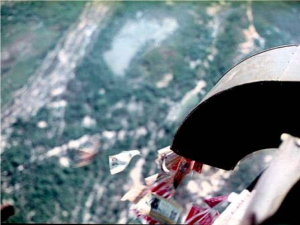
Leaflets dispensed through a chute in an Iroquois helicopter.
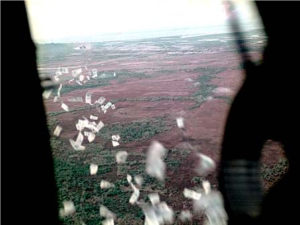
An air drop of leaflets somewhere over Phuoc Tuy Province.
If a standard helicopter was not available from 9 Squadron RAAF, one could be ordered through the Air Cell at Headquarters 1ATF from the United States Army at Bien Hoa. Sometimes a helicopter with transmitting speakers was ordered (see below).
The air team would bring along Chieu Hoi themed messages for broadcast via a reel-to-reel tape recorder mounted in the aircraft (see below).
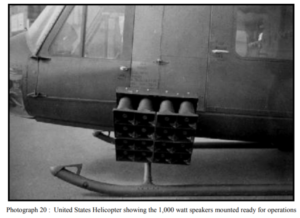
1000 watt speakers mounted on an Iroquois helicopter
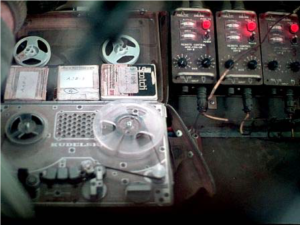
Broadcast equipment mounted inside a helicopter
While the tape was playing, the Air Team operator would lay on the helicopter floor with the door open while he continuously threw handfuls of leaflets out of the aircraft. However, using this method, leaflets tended to fall in an unsatisfactory uneven pattern. The Air Team radio callsign was Litterbug 13.
We believed that these taped messages worked much better when played at night. Helicopters were generally unsuitable for audio broadcasting as the helicopter made too much noise and at times drowned out the broadcast message. This improved when the Australian Pilatus Porter arrived in country.
The Ground Teams
The ground teams’ territory was made by dividing the province into two. In my time Team 3 looked after the north of the province and Route 15 and their callsign was Litterbug 12. Team 2 (my team) looked after the southern part of the province. The Ground Team 2 callsign was Litterbug 11. The Ground Team tasks were to:
- Support Village Cordon and Search operations
- Support roadblock and identification operations on province roads.
- Support Chieu Hoi programs in conjunction with Armed Propaganda Teams
- Support Civil Affairs programs including:
- Integrated Civil Action Projects (ICAPS)
- Medical Civil Action Projects (MedCAPS)
- Dental Civil Action Projects (DentCAPS)
- Safety education programs
- Public Relations
- School education programs through Health and Safety and entertainment.
- Support to Local Forces including:
- Revolutionary Development Cadre (RDC)
- Armed Propaganda Team (APT)
- Province Recon Team (PRT)
- Regional Force units (RF)
- Popular Force units (PF)
- Police detachments
- Political Warfare (POLWAR) Operations
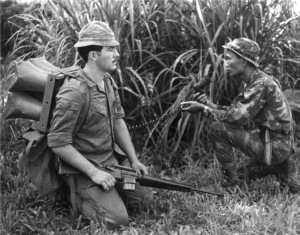
Corporal Arthur ‘Tiger’ Feltham with man-packed broadcast equipment and
power supply adapted from AN/PRC 25 set radio batteries accompanied by an ARVN Interpreter, broadcasting messages to villagers.
Working with Armed Propaganda Teams.
Armed Propaganda Teams (APTs) were former Viet Cong fighters who had rallied to the South Vietnamese government through the Chieu Hoi program. While undergoing retraining at the Chieu Hoi Centre they had been found suitable to be retrained and placed in armed teams. They operated under a program controlled by a District Military Commander. They were to travel to villages and visit families of known Viet Cong members. The names of these known Viet Cong members were on lists which were called ‘Blacklists’. The Armed Propaganda Team members could talk about their own experiences living as a Viet Cong soldier, and the hardships experienced. They could refute the stories told by Viet Cong leaders and Political Officers about Viet Cong battlefield successes and their exaggerated claims of Australian or ARVN defeats. An example of this was when I was to work in the villages of Dat Do district. My contact was the United States District Advisor. He sat down with the South Vietnamese Dat Do District Commander and together they decided what villages to target. My Ground Team would travel with the APT Team. At the village I would visit the Deputy for Security. I would inform him of what the teams intended to do. Some had previous experience with the APT teams and in general they were not impressed. I would visit the house of a known Viet Cong on the ‘Blacklist’. Often the only person at home was the wife as her husband was usually working in the fields. Younger children were usually at school. These operations lasted about a week.
The team members visiting the house would include me, my Vietnamese Army interpreter and an APT member. An Australian soldier from my team would wait outside house. He was my protection. With him would be the rest of the APT team. Sometimes the APT members were a nuisance. They would wander in and out of the house, talk and laugh loudly, and be generally disinterested. They tended to disrupt the conversation I was trying to have with the homeowner. They seemed to have no qualms about going through the homeowners’ personal belongings. All members of the APT carried .30 calibre M1 Carbines with a 30-round magazine. I didn’t regard them as a satisfactory force as they only wanted to sit in roadside rest stops so they could eat, drink and sleep in the hammocks provided for travellers.
As we had never been trained or advised how to do this job, I tackled it this way. I told those who were in the house that I was a representative of the Vietnamese Government. Not surprisingly, that was something they never seemed to believe. I enquired about their relatives on the ‘Black List’. Sometimes they told me that they had not heard from them for a long time, or they never listened to the family if they had been in contact. I asked them if they had heard of the government’s Chieu Hoi returnee scheme. Some said yes and some replied no. I told them the benefits of the scheme. I thought this was more effective when I could hear helicopters flying nearby or when artillery was firing. It allowed me to say that I hope that the government was not attacking their relative’s unit.
Their responses from the homeowner seemed to fall into three categories. Some sat there and said nothing. Some appeared to respond positively to the messages. A few argued about the rights and wrongs of the South Vietnamese government or wanted to say why they thought the Viet Cong were going to win.
I would suggest that there are not many Australian soldiers that can do this type of work. You cannot be aggressive. You have to listen carefully. You have to keep a smile on your face at all times. You must never raise your voice and you must always thank the homeowner at the end of your visit. These skills are important in the Psyops game. I have thought that someone in Central Army records or at Army Headquarters should be keeping a record of Army personnel with these skills, just as they do with skills formally attained through training courses. Personnel posted to positions in Psyops should be drawn from those who demonstrate these skills. Psyops warriors need to have some special qualities. They need to be independent, self-motivated, outcome oriented, and to have more than a touch of salesman in them.
I also worked with the Revolutionary Development Cadre (RDC) doing the same work. Unlike the APT, they were utterly professional. These RDC groups knew what was going on in their villages and were an asset to our work. They lived in the villages and provided agricultural advice and support along with a dose of political indoctrination in support of the government, so their lives depended to a considerable extent on recognising the subtle changes in the political allegiance of the villagers. They sometimes had Viet Cong rally to the government as a result of the work they did.
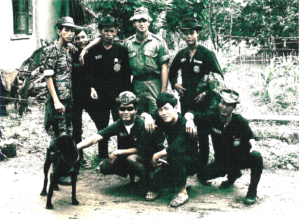
The writer shown second from right in back row was the Psyops Ground Team Leader with members of the RDC Team at Hoi My, Phuoc Tuy province South Vietnam during ‘face-to-face’ POLWAR
operations. c. July 1970. Note the ‘black pyjamas’ uniform worn by the RDC to look similar to the working attire worn by the villagers. No visible weapons were carried in the village during face-to-face operations in secure areas.
Leaflet production
One of the major jobs of the unit was to produce leaflets for air dropping to the enemy or distribution among civilians. The unit designed leaflets using various themes such as those urging Viet Cong to rally to the government (i.e., to Chieu Hoi), safety leaflets warning civilians to avoid unexploded munitions, or encouraging motor vehicle safety. Posters were also produced for distribution by the Civil Affairs Unit about health and safety, and new agricultural techniques such as (believe it or not) how to make wine out or sorghum. Of the total effort the unit expended on leaflet production, the approximate break-up according to theme was as follows:
- Chieu Hoi theme – 46%
- Safety, aimed towards the civil populace – 20%
- Leaflet aim towards demoralising the enemy – 22 %
- Hoi Chanh leaflets with returnees photo and appeal on them – 10%
- Counter-propaganda leaflets – 2%
- Support for 1st Australian Civil Affairs Unit – 2 %.
In addition, there were leaflets called ‘Safe Conduct Passes’ and these were produced by the Americans and given to the Free World Military Forces in country to disperse. Enemy soldiers could use a ‘Safe Conduct Pass’ to rally to the government. The pass ensured that they would be treated as a Chieu Hoi (rallier) rather than a prisoner of war. Throughout the campaign the 1ATF Psyops unit would have air-dropped over 4 million of these in the Australian Area of Operations.
Some examples of the leaflets designed to influence the Viet Cong soldiers were:
Leaflets showing numbered graves of Viet Cong killed by Australians over recent months. On some graves the numbers were replaced by question marks. The words suggested that the enemy soldiers should return to the government of they could be next to find themselves in a grave.
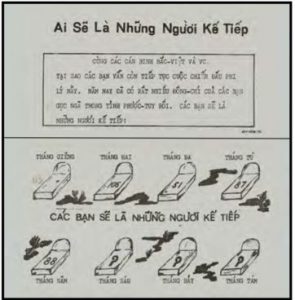
Australian leaflet ATF-004-70
Front of leaflet: Who will be next? Soldiers of the VC and NVA! Why do you continue this senseless struggle? Already this year many of your comrades have been killed in Phuoc Tuy Province. Will you be next?
Reverse side: Will you be next! Months – Jan (113), Feb (105), Mar (51), Apr (87), May (88), Jun (?), Jul (?), Aug (?).
______________________________________________________________________________
Interrogation of ralliers showed that one of the main motivators for rallying was homesickness. This homesickness was exploited by leaflets depicting a mother and child thinking about a lonely soldier on the battlefield. The flip-side showed a soldier in the jungle thinking about his family. The aim was to demoralise the soldier and encourage him to rally and possibly return to his family.
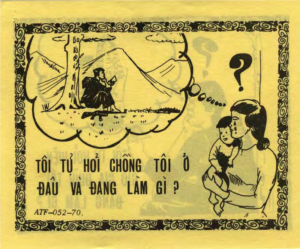
I wonder where and what my husband is doing today?
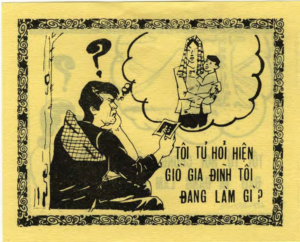
I wonder what my family is doing today?
Many Hoi Chanh’s were illiterate but some were educated and could write. If this was the case they could be exploited to encourage further ralliers from their unit. They could be coached into writing (in their own words) a reassuring letter about the benefits of rallying which could be produced as a leaflet and dropped to their comrades still in the jungle. Usually, the flip-side of the leaflet showed a photograph of the rallier looking happy, generally with a cigarette in one hand and a Coca-Cola in the other. This was intended to let their comrades know that they were well treated and happy. Their comrades would recognise the writing of their former comrade or if some were illiterate, they would recognise the happy photograph of their former soldier.
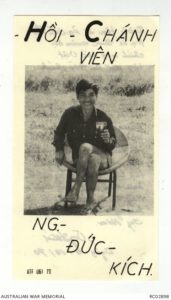
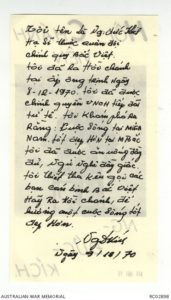
Translation:
Front: Picture caption – Rallier Nguyen Duc Kich
Reverse: I am Nguyen Duc Kich, a former corporal in the NVA. I returned to the GVN at Ong Trinh on 8 December 1970. I was warmly welcomed by the GVN. I reveal that living in South Vietnam is much better than the North. I eat good food and sleep well. I heartily call upon you, cadre and soldiers of NVA to return to the GVN, so that you can have a better life.
______________________________________________________________________________
Some themes were based on the outcome of operations, such as the incursion into Cambodia, or that Viet Cong leaders were not telling their soldiers the truth about the war.
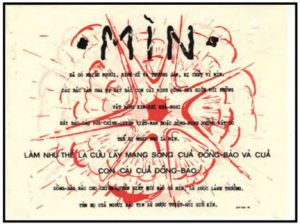
Australian Leaflet ATF-013-70
English translation: Mines. Many people, soldiers and civilians, have been killed or wounded by mines. Parents – tell your children not to play with strange metal objects. Report anything that could be a mine to GVN or Allied authorities. This could save your life or the lives of your children. Rewards are paid for information about mines. The identity of the people will be kept a secret.
______________________________________________________________________________
The leaflet above and others produced for distribution within the civil population were designed to emphasise safety. This particular leaflet warned citizens about the dangers of land and personnel mines, but other leaflets warned citizens about road traffic safety and other risks.
Any message, whether a voice message or a message on a leaflet needs to be accurate. At one time the Detachment of 1 Division Intelligence Unit had interrogated a rallier who said his Viet Cong commanding officer was ill. Documents had also been captured suggesting the officer was ill. From the symptoms described by the rallier and the captured documents, a 1ATF doctor ‘diagnosed’ tuberculosis. To exploit this opportunity, and to create a sense that 1ATF and the South Vietnamese government forces were all-knowing, the Psyops unit produced a leaflet shown below.
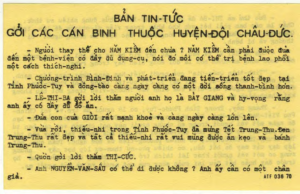
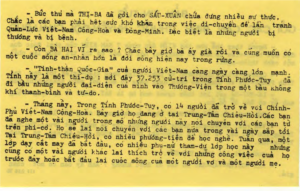
Translation: Newsletter for Chau Duc. Will the replacement for Nam Kiem arrive soon? It is very necessary to get Nam Kiem to a good hospital where tuberculosis can be properly treated. The Pacification Program is working well in Phuoc Tuy, and the people are more and more able to lead peaceful lives. Le Thi Ba sends her best wishes to her cousin Bay Giang, and hopes that he is getting enough to eat. The baby of Gioi is very well, and is growing bigger every day. The children of Phuoc Tuy recently celebrated the mid-autumn festival. The lanterns were very pretty, and the children all enjoyed their cakes and sweets. Quon sends his love to Thi Cuc. Is Nguyen Van Sau able to walk properly? He should be given a proper artificial leg.
Reverse: The letter which Thi Ba Thao wrote to Sau Xuan on 10 Sep contains much truth; it must be very difficult to move quickly to avoid GVN and allied troops. Those of you who have to carry some of the wounded and sick must have especial difficulties. How is Ba Hai? Now that he is becoming older, he must surely wish to lead a peaceful life instead of existing in the jungle. The national spirit of Vietnam is becoming greater by the day; this province is one example: 37,253 people of Phuoc Tuy recently voted in peace and freedom for the people to represent them in the Senate. This month, 14 have rallied to the GVN in Phuoc Tuy alone. They are now at the Chieu Hoi centre; you have heard some of them talk to you from the air. They will talk to you again within the next few days. Listen to them: they are free and enjoying new lives. At the Chieu Hoi centre there are facilities for learning a trade; last week a course in tailoring was started, many women joined but some preferred to go back to their old jobs or to start once again as a proper wife and mother.
______________________________________________________________________________
Unfortunately, the commander of Chau Duc local force unit, Nam Keim, recovered from his illness and did not have tuberculosis. The assumption contained in the Australian leaflets was proved to be incorrect and therefore that leaflet and others could be easily discounted by Viet Cong political officers and said to be just ‘propaganda’ without substance.
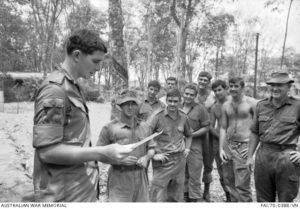
The Officer Commanding 1st Psychological Operations Unit, Captain Frank Leslie Meredith, reads a captured Viet Cong document to members of his unit at the 1ATF base. The document expressed concern at the successes of allied psychological warfare programs. Identified beside Captain Meredith, left to right: Sergeant Derrill de Heer, Team Leader; Trooper Anthony ‘Tony’ Cullen; Corporal David ‘Doc’ Finlay; Private Daniel ‘Speedy’ Wright; Corporal Ian Botham; Lance Corporal Wladyslaw ‘Wally’ Koscielecki; Gunner Harold Smith; Sergeant Russell Tetlow, Intelligence Sergeant
______________________________________________________________________________
One theme that was tried on the enemy was called ‘Wandering Souls’.[4] This was a tape played by the Air Team using aircraft equipped with loudspeakers. It was also used by the Ground Team, but not in the vicinity of South Vietnamese soldiers. There were several versions of this message played throughout Vietnam by Free World Military Forces. The Air Team broadcast this tape using helicopters and a US Army aircraft specially equipped for Psyops. This was a Cessna O2B push/pull twin-tailed aircraft with a bank of loudspeakers built into the airframe at an angle. When the Australian Pilatus Porter aircraft arrived in country in 161 Independent Reconnaissance Flight, it was also used for Psyops audio broadcasts. The Pilatus Porter was particularly well suited to audio broadcast operations because the loudspeakers could be mounted inside the aircraft pointing straight down through a hatch in the floor. The aircraft could fly straight and level at just above stall speed to reduce the masking effect of the aircraft engine noise.
The ‘Wandering Souls’ tape was about 20 to 30 seconds long. The first half of the tape was ‘electronic’ music with a soft male voice-over saying that he is wounded and is dying and asking where is home? The music then changed to distorted and spooky ‘psychedelic’ music while the now ghostly voice states that he is now dead, and his spirit is wandering.
The tape was designed to play upon the spiritual beliefs of Vietnamese soldiers. In Vietnamese culture families are required to perform rituals over the dead to allow their ‘wandering soul’ to find rest. This tape aimed to make enemy soldiers think about the possibility of dying in a remote jungle location where their remains would never be found and their spirit would be destined to wander the spirit world forever in torment. To avoid this dreadful fate they could rally to the government under the Chieu Hoi scheme. The wandering souls tape was believed to be highly effective. The tape was so scary that one allied pilot I met refused to fly Psyops missions if the tape was to be broadcast.
In this type of work, it is hard to know if your activities had any effect on the enemy. Interrogation of ralliers and prisoners of war can sometimes provide clues but the first time we received concrete evidence of our success occurred when an enemy courier was killed. This person carried several directives from the higher headquarters to be delivered to units under their command. One of these directives instructed all commanders that if they became engaged with the enemy (Americans or Australians) and had soldiers killed, they were ordered to collect all their own bodies from the battlefield at all costs and bury them properly. This was aimed at nullifying our ‘Wandering Souls’ campaign by reassuring their soldiers that they would receive a proper burial. Our program seemed to be a great success.
One of the many tasks I had, was to interview the Hoi Chanhs about four to six weeks after they had returned to the government. They were still with the Chieu Hoi Centre which was located east of the provincial capital Baria and close the Van Kiep military base, and this was where the interviews were conducted. If they were found to be illiterate they could not be successfully exploited as they could not write messages for leaflet production. However, if literate and they agreed to assist us, then we would interview them. We had a standard set of questions we would ask them. Questions were about our leaflets, such as did they see any, did they read them (their political officers forbade them from reading the leaflets), what was the theme of the leaflets they saw, etc. When discussion turned to messages from a voice aircraft, we asked if they had heard any and if so, what was the theme. Most Hoi Chanhs had heard the voice messages but could not remember the message. Others could sometimes remember the themes but not the specific content of the message. It was during one of these interviews that a returnee replied for the first time that when our aircraft flew over the base or camp area, the Political Officer ordered them underground into the bunkers so they could not hear our message. This was the first time I realised that the enemy had employed a simple but effective counter-measure to the air broadcasts.
While this was a countermeasure to the broadcasts it did not stop us from broadcastings as we still targeted those enemy troops on the move or those moving through the Australian Area of Operations.
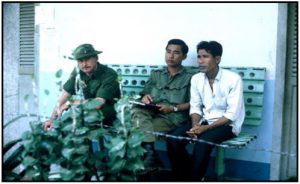
Sergeant Wayne Stone (left) with Staff Sergeant Ruong and a North Vietnamese returnee at the Ministry of Information, Chieu Hoi Centre east of the province capital Baria in Phuoc Tuy Province. The returnee was killed by a mine some time later while assisting Australian forces.
______________________________________________________________________________
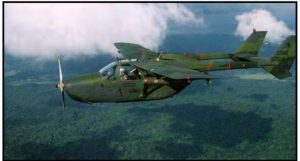
USAF 02A Push/Pull Cessna ‘Skymaster’ aircraft. The O2B model is the same aircraft but without the rocket pods under the wings. On the left hand side, behind the pilot and built into the fuselage was an external speaker for broadcasting Psyops messages.
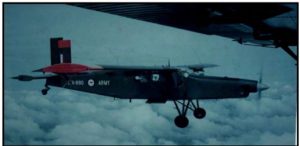
Pilatus Porter aircraft of 161 Reconnaissance Flight, 1ATF, with underneath hatch door open. If carried, broadcast speakers mounted in the aircraft protruded from this hatch.
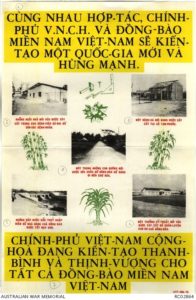
Translation:
Together, the government of Vietnam and the people of South Vietnam will build a strong and new nation. New buildings at Baria hospital to treat the sick. A new dispensary at Tam Phuoc Village. One of the new roads for you to bring your goods to market. Irrigation dams to give you bigger and better crops. New Technical Schools to give better education to your children. The GVN is working for peace and prosperity for all the people of South Vietnam.
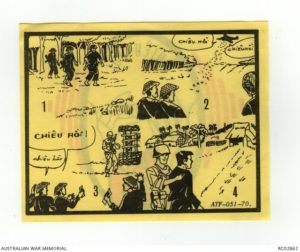
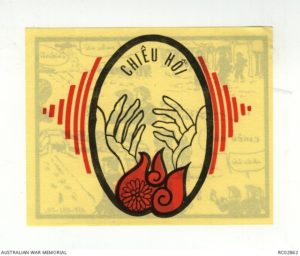
Translation:
Front: (1) VC walking through the jungle (2) VC listening to a voice aircraft and picking up leaflets (3) VC rallying to a GVN outpost (4) Hoi Chanh being given a house.
Reverse: Chieu Hoi open arms symbol.
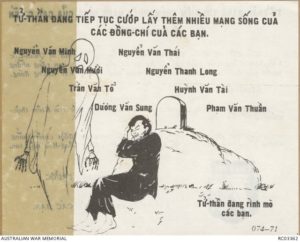
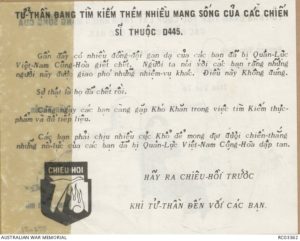
Tranlation:
Front: Sleeping VC; grave in the background; ghostly shape of a former comrade in attitude of appeal; names of dead D445 soldiers. (Top) The shadow of death continues to seek more of your brave compatriots. (Below) The shadow of death is looking for you.
Reverse: The shadow of death is searching for more members of D445. Many of your brave compatriots have been killed by the GVN forces recently. You have been told that such people have been given other tasks. This is not true. These people are dead.
Each day the task of getting enough food and supplies becomes more difficult. You labour hard to achieve victory but GVN forces destroy your effort. Chieu Hoi before the shadow of death reaches out for you.
Chieu Hoi symbol.
For researchers
Those interested in further research on the operations of the 1st Australian Psychological Operations Unit in Vietnam should consult my MA thesis where they will find an extensive bibliography of relevant research materials. The thesis citation is:
Derrill de Heer, ‘Victoria per Mentum: Psychological Operations Conducted by the Australian Army in Phuoc Tuy Province South Vietnam 1965-1971’, (MA Dissertation 2009), UNSW Canberra. Available for viewing or download at https://www.unsworks.unsw.edu.au/primo-explore/fulldisplay?vid=UNSWORKS&docid=unsworks_4962&context=L
The Australian War Memorial photographic collection includes numerous photos depicting the work of the Pysops Unit. Examples are:
- Photographs
- AWM JON/70/0390VN
- AWM JON/70/0387vn
- AWM FAI/70/0399VN
- AWM Photograph 17. Warrant Officer II Sam Booth with Hoi Chanh at the Provincial Chieu Hoi Centre.
- I have a private collection of Psyops-related photographs, some of which appear in this article. These include the following:
- Sergeant Wayne Stone with interpreter exploiting a Hoi Chanh. Note the relaxed style of interviewing.
- Helicopter with broadcast speakers fixed on outside
- Photograph 32: United States Air Force 02A Cessna Skymaster. The 02B model was developed specifically for Psyops loudspeaker operations.
- Australian Pilatus Porter aircraft used for voice missions and limited leaflet drops.
I have deposited a collection of approximately 120 1 Psyops Unit leaflets and posters with the Australian War Memorial. Researchers can access these through the Australian War Memorial web site or on line at https://www.unsworks.unsw.edu.au/primo-explore/fulldisplay?vid=UNSWORKS&docid=unsworks_4962&context=L They cover a wide range of representative themes. Those reproduced in this article include:
- ATF-004-70: ‘Will you be next!’ – VC graves
- ATF-061-70: Smiling Hoi Chanh with drink
- ATF-013-70: Beware of mines and unexploded ordnance
- ATF- 014-70: Benefits of government support
- ATF-036-70: Nam Kiem’s illness
- ATF-051-70: VC solder rallies to the government
- ATF-052-70: ‘What is my family doing today’ – VC dreaming of family
- ATF-074-71: Ghost of dead comrades urges VC to rally
Notes:
[1] Sergeant Derrill de Heer initially served in 8RAR deploying to Vietnam in November 1969. After five months in country, Derrill transferred to 1st Psychological Operations Unit at Nui Dat, returning to Australia in November 1970. Derrill had a second tour with 4RAR/NZ (ANZAC) as the Intelligence Sergeant, deploying in September 1971 and returning to Australia with the battalion in December 1971.
[2] Sun Tzu, The Art of War: Book and Card Deck. Trans. The Demma Translation Group, Shambhala Publications Inc. Massachusetts. 2003.
[3] The Division in Battle, pamphlet no. 11, Counter Revolutionary Warfare, 1965, Military Board, Army Headquarters Canberra, 1/3/66, p. 58.
[4] This theme was called Wandering Souls as was about the leaving of bodies on the battlefield. There is a belief that if you die violently or die where you are not known you spirit will wander and will not find peace until the appropriate ceremonies was carried out at the grave or the area where the body might lie.

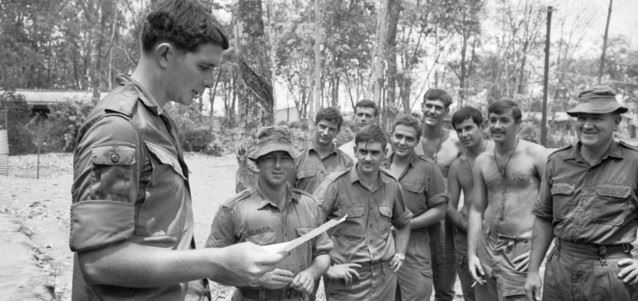
2 Comments on “Australian Psyops in Vietnam 1970”
From Ernie Chamberlain: The extract from Derrill de Heer’s MA Thesis is a very important detailed and “first-hand” contribution to our understanding of 1 ATF’s Psychological Operations and “Chiêu Hồi/Rallier/Open Arms” programs (see also pp.138-142 in Ekins, A with McNeill, I., Fighting to the Finish, Allen & Unwin/AWM, 2012). Statistics for the Chiêu Hồi program in Phước Tuy were reportedly: 1965: 77 ralliers/defectors/returnees (hồi chánh); 1966: 278; 1967: 317; 1968: 45; 1969: 121; 1970: 196; 1971 : 37 – for seven years 1,071 (National: 176,756). The 1963 and 1964 rallier figures were not broken up by province. There were reportedly 20,242 ralliers in 1966, and a US cost-benefit analysis reported an assessed overall cost of USD 125 for each rallier – that had indicatively saved the lives of 3,000 “Free World Forces” – Williams, O., Some Salient Facts …, 14 February 1967.
The Đất Đỏ District History District History (2006) related that: “The enemy’s poisonous psychological warfare practices caused us considerable damage. In the Province in the first six months of 1966 – in Châu Đức District alone, there were 22 cases of surrendering to the enemy. From January to October 1966 – in the whole of the Province, 66 cadre and soldiers surrendered, abandoning their duty ie to return and make their living with their families.” Report of the Province Committee dated October 1966, Party Central Office Archives, Office of the Eastern Nam Bộ Regional Committee. However, in May 1972 – after the withdrawal of 1 ATF, the US Province Senior Advisor in Phước Tuy Province declared the program was “largely moribund”, and was inducing few VC to defect. – Ekins, A. with McNeill, I., Fighting to the Finish, op.cit., 2012, p.648, p.1054 – endnote 33. A 1973 US report (J.A. Koch) estimated that “The program reached its peak in 1969 with a rallier return of 47,023. The three basic principles governing the Chieu Hoi rate were in operation ie: a good internal organization, a large group of potential ralliers which could be tapped as the GVN expanded its presence into former VC and contested areas, and increased security in controlled areas with a rising tide of economic development reaching down to the village level. The per capita cost per rallier rose to $350. In Phước Tuy, one of the most “senior” VC ralliers was probably Nguyễn Văn Nhường aka Lộc, the commander/deputy of D445’s 2nd Company, who rallied on 29 July 1969 to 6RAR/Regional Forces. Nhường was subsequently employed as a “Bushman Scout” with 1 ATF.
This is accommodating very valuable content, I really appreciate the efforts you’ve putted in this report. Every topic is very clear and understandable.